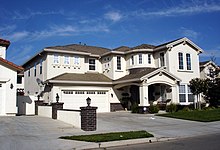
Back Vermögenspreisinflation German Vermogensinflatie Dutch Inflação de ativos Portuguese Lạm phát định giá tài sản Vietnamese

Asset price inflation is the economic phenomenon whereby the price of assets rise and become inflated. A common reason for higher asset prices is low interest rates.[1] When interest rates are low, investors and savers cannot make easy returns using low-risk methods such as government bonds or savings accounts. To still get a return on their money, investors instead have to buy up other assets such as stocks and real estate, thereby bidding up the price and creating asset price inflation.
When people talk about inflation, they usually refer to ordinary goods and services, which is tracked by the Consumer Price Index (CPI). This index excludes most financial assets and capital assets. Inflation of such assets should not be confused with inflation of consumer goods and services, as prices in the two categories are usually disconnected. The prices of some goods and services such as housing, energy, and food do track closely with some financial assets.
Examples of typical assets are shares and bonds (and their derivatives), as well as real estate, gold and other capital goods. They can also include alternative investment assets such as fine art, luxury watches, cryptocurrency, and venture capital.
- ^ Robert, Shiller. "LOW INTEREST RATES AND HIGH ASSET PRICES: AN INTERPRETATION IN TERMS OF CHANGING POPULAR MODELS" (PDF). Cowles Foundation for Research in Economics, Yale University.